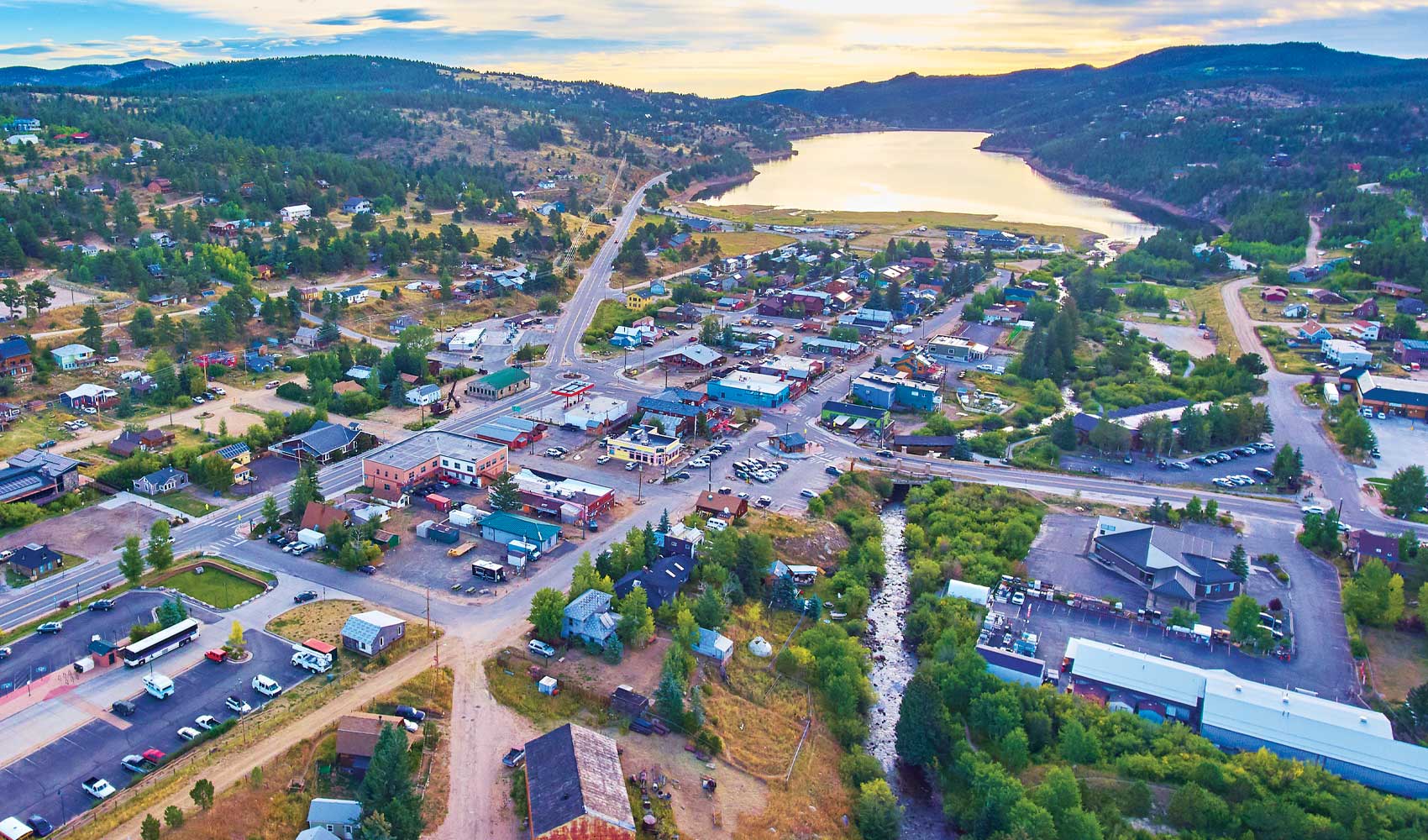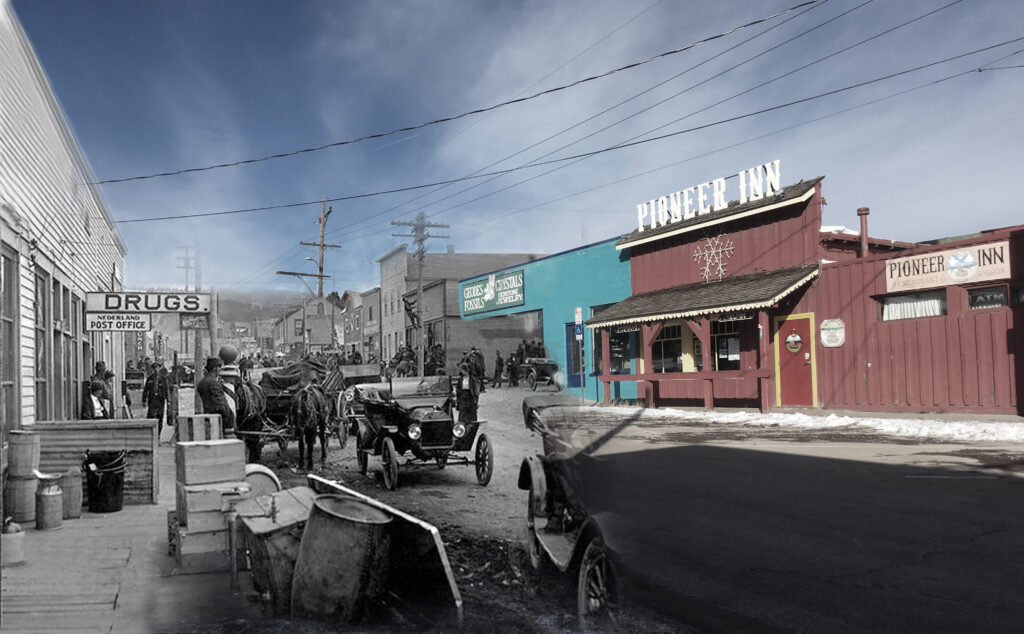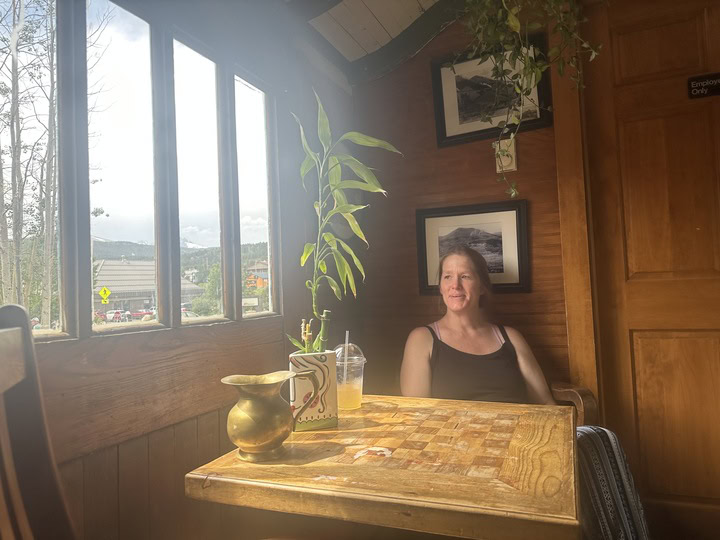
Folks in Nederland measure their time in winters. It’s a badge of honor, emblematic of their ability to withstand hard times. This year marked the town’s 150th.
“You’re huddled down for nine months, wind is howling and the snow is blowing,” says Jess Ansari, assistant director of the library and president of the historical society. “If you’ve survived your first one, you got a good chance.”
Then summer comes and columbines bloom, hummingbirds buzz about town. Moose roam, chomping on lush greenery and wandering the shores of Barker Reservoir. The hard times don’t last forever, but they remind you of what you can endure — and who you endure it with.
“[There’s] a lot of hardiness. The core of the community are people that are really resilient,” says Robin Svenson, general manager at Train Cars Coffee and Kava in town. “We have a running joke: We hear about hurricane winds where they were like 50 miles per hour. And we’re like, ‘Oh, that’s cute.’ That sort of camaraderie around the resilience it takes to live, to really live, here.”
With a sesquicentennial celebration set for Aug. 1-4, the town is celebrating that sense of community — looking back on its past and setting its sights on what it wants to be in the future.

“We’re making history every day,” Ansari says. “It’s about making good choices in the present so the little ones will have a good future and somewhere healthy and clean to live. [Somewhere] affordable that still has character and is interesting and fun and creative.
“We’re trying to keep it a little bit weird, a little bit gritty, a little bit funky.”
‘History repeats itself’
Of course, the area’s history begins before Nederland was Nederland. Originally inhabited by the Ute and Arapaho, the area served as a trading area for the tribes. At one time, there was an Arapaho circle out on the meadow where the reservoir is now, according to local lore, though Ansari says much of the Native history is
“really hard to find.”
Then came the white beaver trappers and their tents in the early 1800s, which Ansari says also has limited recorded history. Later that century, miners came to town “and buildings started popping up everywhere.”
“There’s some possibly inaccurate historical stories about how some of the first silver was found, and they blamed it on one of the tribes, one of the chief’s daughters who hinted that there was a treasure in the mountains,” Ansari said. “These prospectors kind of got wind and went in and didn’t give up until they found it.”
When a Dutch mining company bought the mine in Caribou after it changed hands several times, miners began to call the area 2,000 feet lower than the mine — at the time known as middle Boulder — Netherlands, Dutch for lowlands. When the town was officially incorporated in 1874, the name Nederland stuck.
Silver mining died down around 1890, but the town saw another mining boom at the turn of century when Tungsten was discovered nearby, valuable for making steel. The town boomed during WWI with a population of around 3,000, compared to its current 1,500 residents.
That era’s history has typically been defined by the miners, but Ansari says she’s more interested in domestic and women’s history during that time: “Stuff would have fallen apart if it wasn’t for the women.” Some of that history is on display at the Gillaspie House, a small home that belonged to an early 1900s mayor of the town, Dr. Carbon Gillaspie. The home will be open for tours during the sesquicentennial celebration.
“What a hard life these women lived,” Ansari says. “Their clothes are always so pristine, how hard it would have been just to keep it washed and clean. They’re super, super tough ladies. It kind of resonates with the women that are up here today. The women in the mountains are independent, strong.”

By 1920, the town dwindled to about 100 or 200 residents, Ansari says. As the population plummeted, it became a stop for tourists.
“On the back of the postcards, it was like, ‘Look at this. We went through this deserted town,’” Ansari says.
The road from Boulder was paved in ’40s, and there was another brief boom during WWII. Then came the ’60s, when hippies and draft dodgers moved where they could “be close enough to cities and resources but far enough away that you can live off the grid, hidden,” Ansari says.
“A lot of fights broke out between the old miners and the hippies,” she says. “And it was not just peace-and-love hippies.”
This was the era of the infamous STP Gang known for wearing bones and fur and “causing a ruckus,” according to Ansari. In a Denver Post article, former Boulder County Undersheriff Kirk Long described the gang as “openly defiant, argumentative and intentionally antagonistic.”
One member of the gang, 19-year-old “Deputy Dawg,” was shot and dumped near abandoned gold mines in 1971. It wasn’t until 26 years later that Renner Forbes, the town’s
marshal at the time, confessed to the killing — something that eventually motivated a former gang member known as “Midget Jesse” to attempt a bombing at the sheriff’s office in 2016, some 45 years after the murder.
More positively, that hippie wave also brought artists and musicians to town. The Caribou Ranch music studio, where the likes of John Lennon and Billy Joel recorded, opened in 1971 and remained a destination until it burned down in 1985.
Another colorful moment in Ned’s history came in the late ’70s when a stray female cat named Fred won the mayoral election (more women’s history). Fred couldn’t technically be sworn in, so she served as honorary mayor. As the story goes, Fred’s election came after locals were uninspired by the human candidates. Today, she is buried outside of town hall, her grave reading “Fred the Cat Legend of First Street 1972-1989.”
“There was a lot of turmoil with the town trustees and mayors, and there were always recalls going on back in the ’70s and back in the turn-of-the-century 1900s,” Ansari says. “And today — I think the last attempted recall was just a few years ago.
“The fights are kind of always about the same thing over the last 120 years — land use and where the budget goes. History repeats itself.”
Today’s time capsule
That political, and sometimes polarized, spirit remains today in Nederland, residents say.
“People are really passionate here,” says Train Car Coffee’s Svenson. “There’s not necessarily always cohesive passions, but there’s people that will really take the reins.”

She says those passions range from wildlife to the future of festivals in the community. Frozen Dead Guy Days, a festival dedicated to a cryogenically frozen Norwegian man whose body rested in Nederland, moved to Estes Park in 2023 after calling Ned home for two decades. (The festival’s namesake rested peacefully in a Tuff shed outside town until it moved to the Stanley Hotel this year.)
The move came after clashes between town leadership, event organizers and residents, ostensibly over concerns like traffic and safety. In its final year, the festival drew 20,000 people to the small town. A new festival in homage to the town’s feline mayor, Bizarre Cat Bazaar, began last year.
Strong opinions also surround development. Much like in the rest of Boulder County, it’s a dominant and divisive issue in local politics.
“There’s always controversy when a bigger, boxier-looking building comes up: ‘Well, that’s a step towards kind of becoming Aspen or an anywhere, USA town,” Ansari says.
“It’s trying to find that balance,” of preserving the town’s character while making sure the people who live and work in the community can continue to do so.
It’s also a challenge balancing the needs of business owners and residents amid growing traffic to and through the town.
“Our sales tax revenue goes up, but the infrastructure isn’t really built for it,” says Kyle Busey, owner of local barbeque joint Busey Brews. “I guess it happens with all small towns: make the decision if they’re gonna grow with the change or resist the change. I think that’s where Nederland is at right now.”
In defining Nederland’s eras, Ansari says “now, our history is recreation.”
That recreational day use is one of the biggest changes Svenson has seen in recent years: “bombardment of people just here for the day in the community and how that affects our day-to-day lives on the whole stretch of Peak to Peak,” the highway that runs from Central City through Nederland to Estes Park.
“It’s just this intense blast of people and then it’s like, people are gone,” she says. “By 5:30 this afternoon, it will look totally different around here than it does now.”
On the plus side, Svenson says, growth has improved the quantity and quality of services like the food pantry, which has a clothing closet and community garden, and mental health services such as Mental Health Partners and Peak to Peak Counseling, as well as options for affordable housing.
But when Svenson thinks back on the most memorable moments from her time in the town, many of them feel painful or too personal to share. She’s lost several friends to fentanyl overdoses in recent years. She remembers a shooting at Eldora Ski Area in 2008 that left general manager Brian Mahon dead after an employee opened fire, and the 2016 bombing attempt. In 2011, NedFest organizer Mike Torpie took his own life in the Safeway parking lot, she recalls as she points to the site from her favorite of the three train cars on the cafe’s grounds.
“I want to say happier things, but the truth of it is, things that stick out are the things we had to be resilient through,” she says as an afternoon storm rolls in. “Those are the places where I really feel we’ve shined as a community.”
Next door, the Carousel of Happiness goes round, with kids and adults alike bobbing in lazy circles atop the hand-carved wooden animals. The passion project of Nederland resident Scott Harrison, the carousel was dreamed up by the young marine in Vietnam, who had a tiny music box given to him by his sister “that he held to his ear to distract him from the horror of the war going on around him,” according to the carousel’s website. “The music, Chopin’s ‘Tristesse,’ brought him a peaceful image of a carousel in a mountain meadow.”

After rescuing the carousel frame in the late ’80s, Harrison spent the next 26 years carving a cheetah, a peacock, a dragon and a moose — dozens of animals — no two alike. The carousel opened on Memorial Day 2010. Pat Hagberg, who has lived in the mountains outside of Nederland for 45 years, works at the carousel and says she loves the job for the cheer it brings people and the stories it brings out of them.
“Adults need it more — way more,” she says. “Children, I’m not gonna say they take it for granted, but they’re just happy little beings. Adults, a lot of times, need a little help.”
Tristesse, the name of the song that inspired the carousel, is the French word for sadness, seemingly at odds with the carousel’s very name and purpose. But perhaps that duality is what makes the joy so poignant, just as Nederland’s brutal winters help forge the tight-knit community locals hold so dear.
“The world’s not the happiest place sometimes,” Hagberg says. “Here, I think people find happiness.”
********
COMING UP: Check out the schedule for Nederland’s 150th celebration here.
